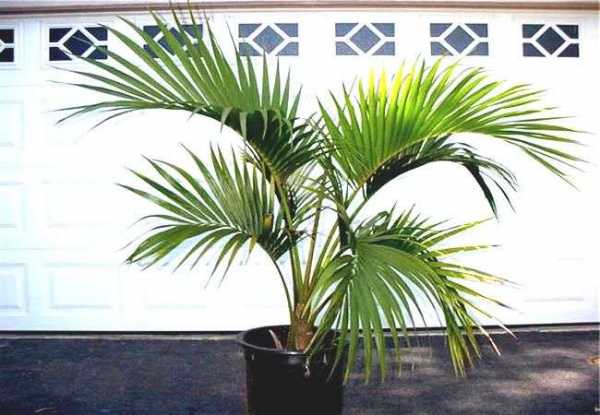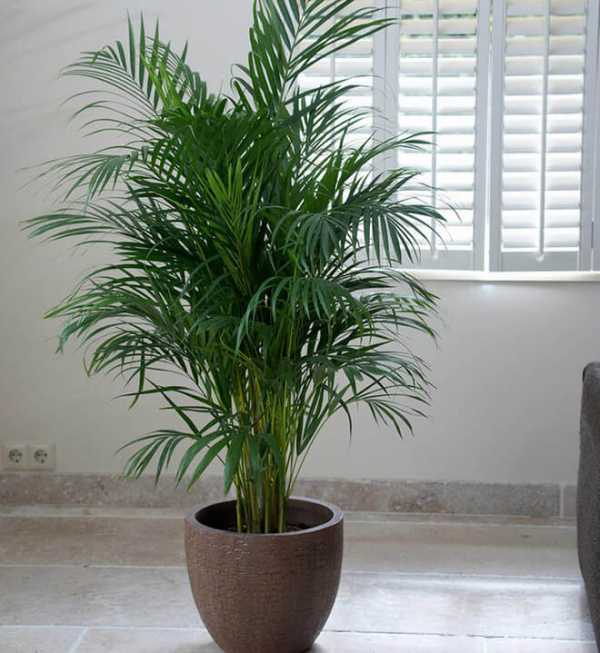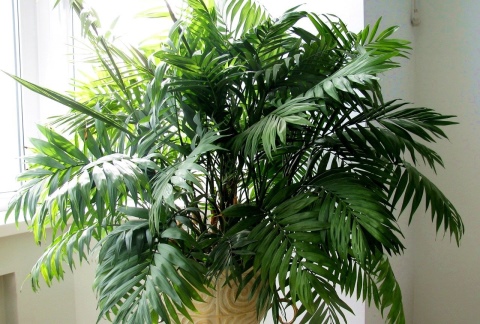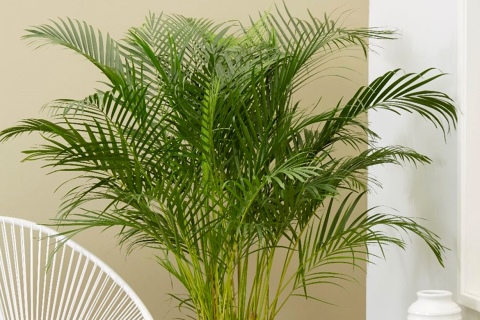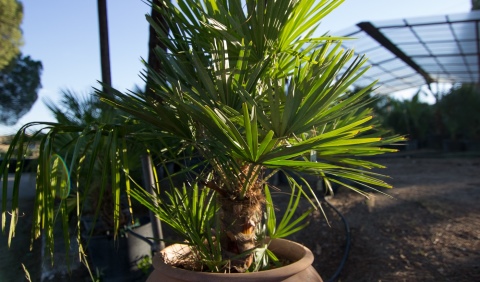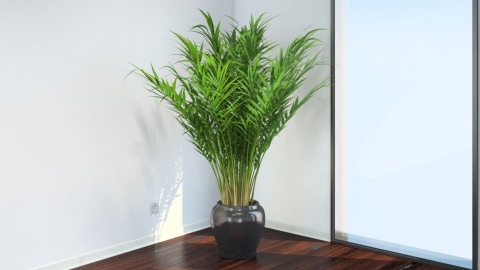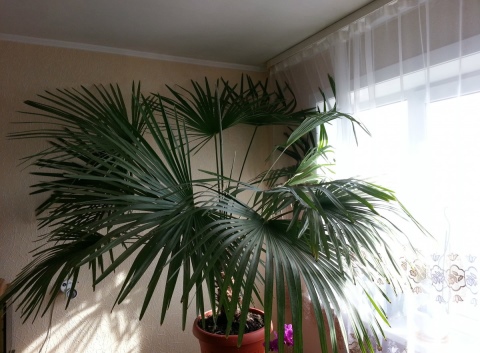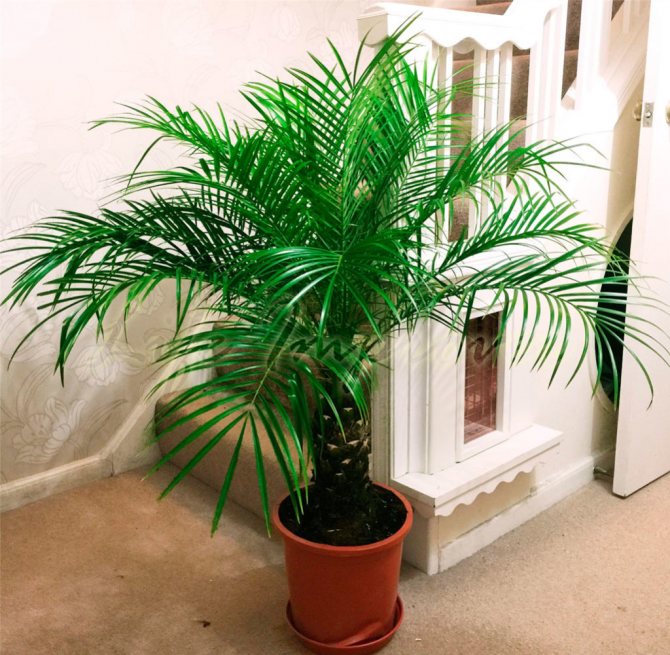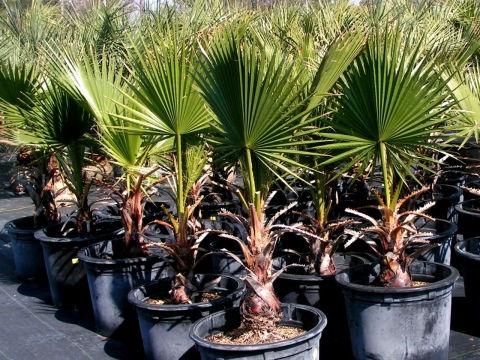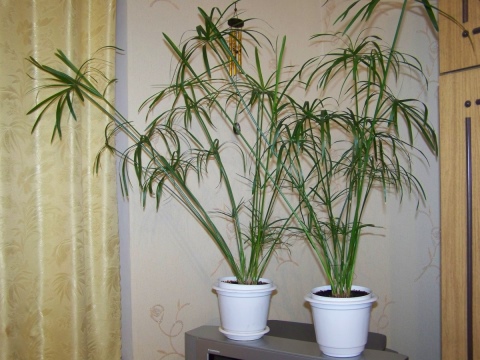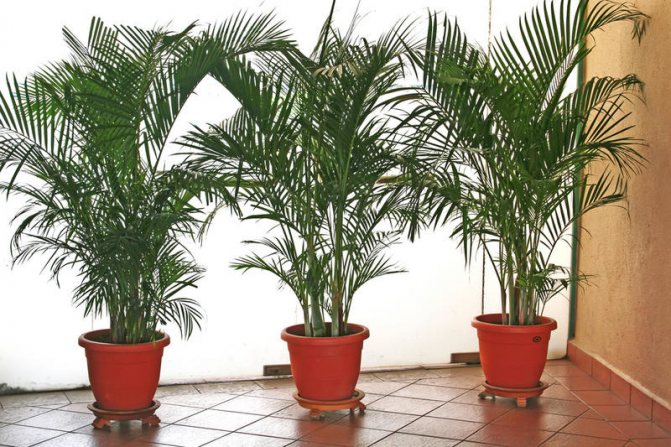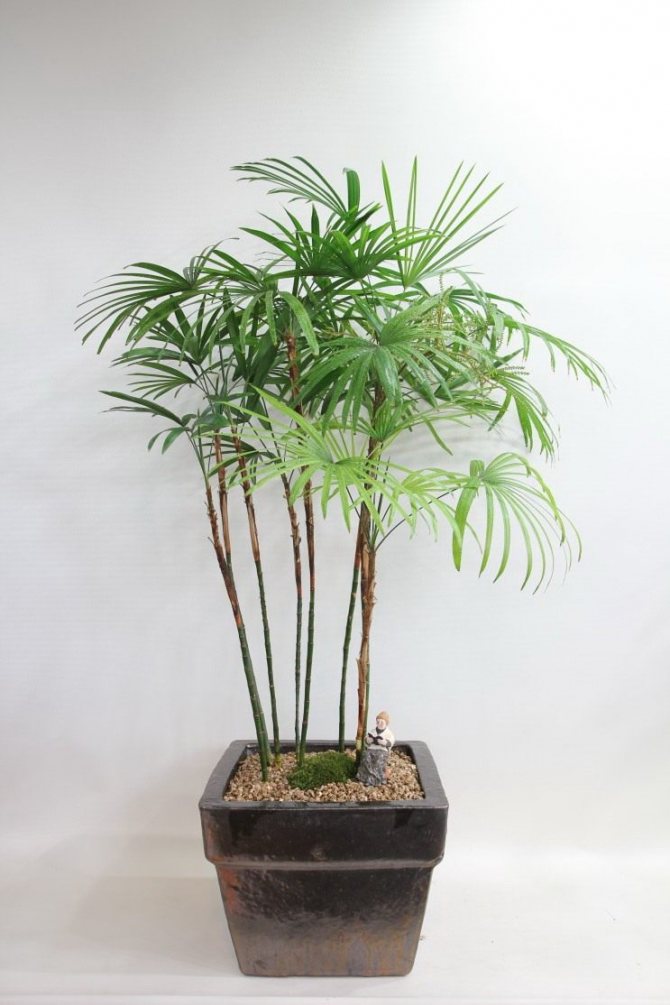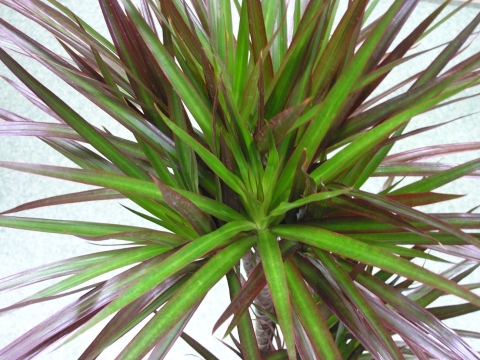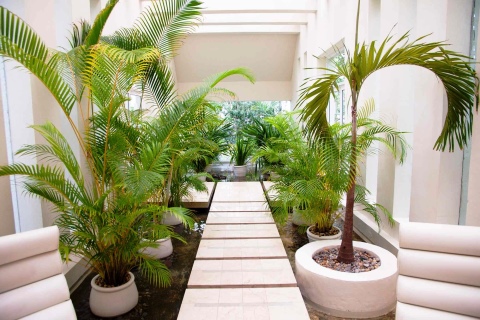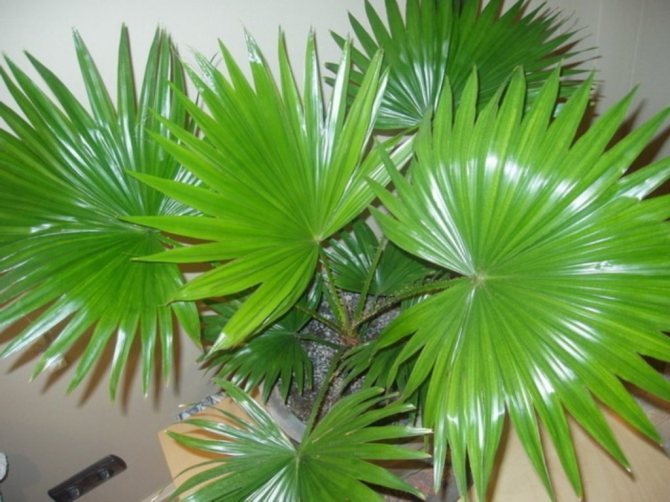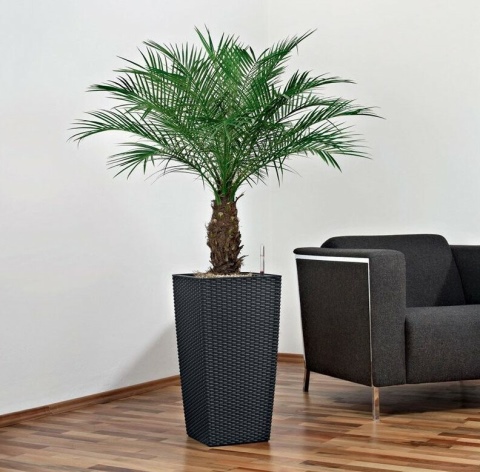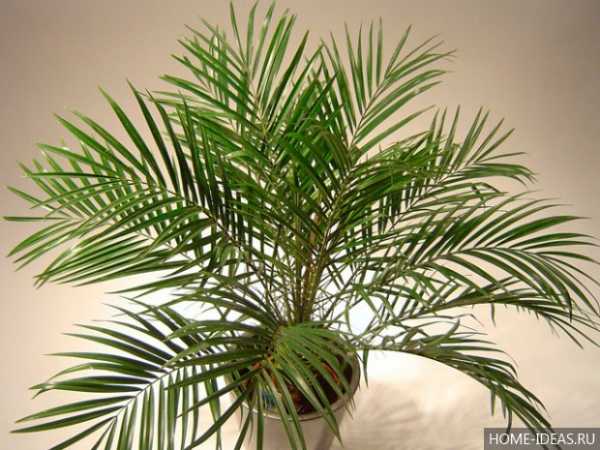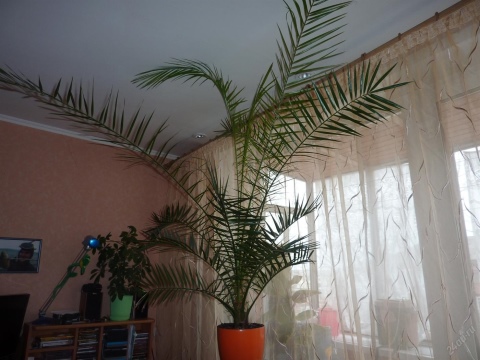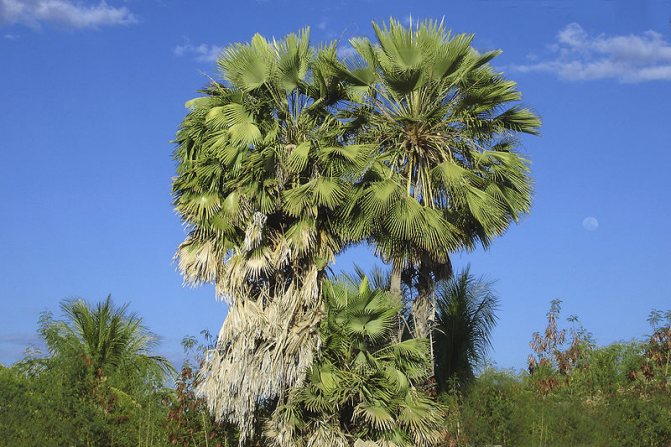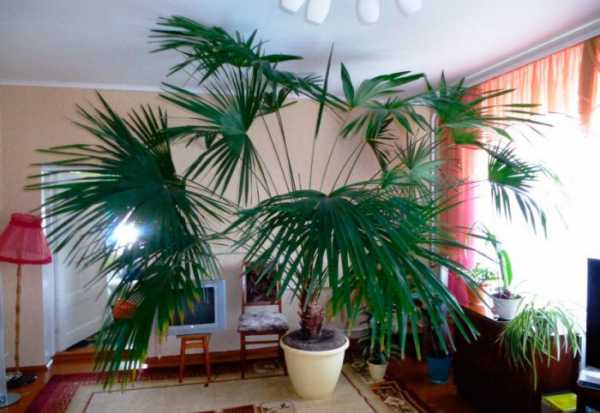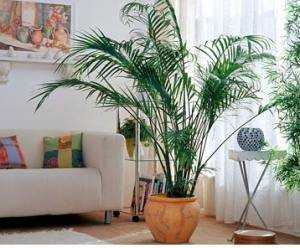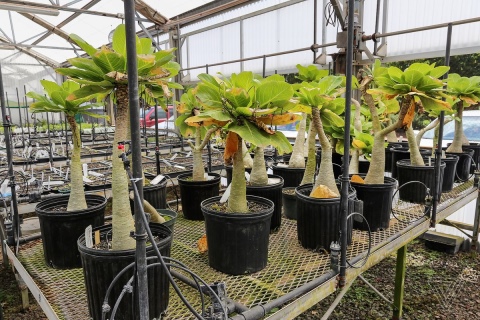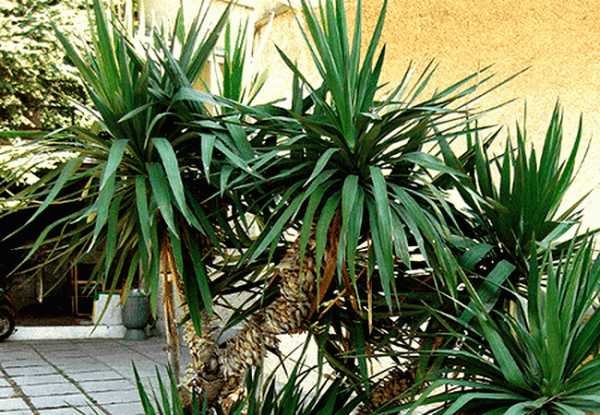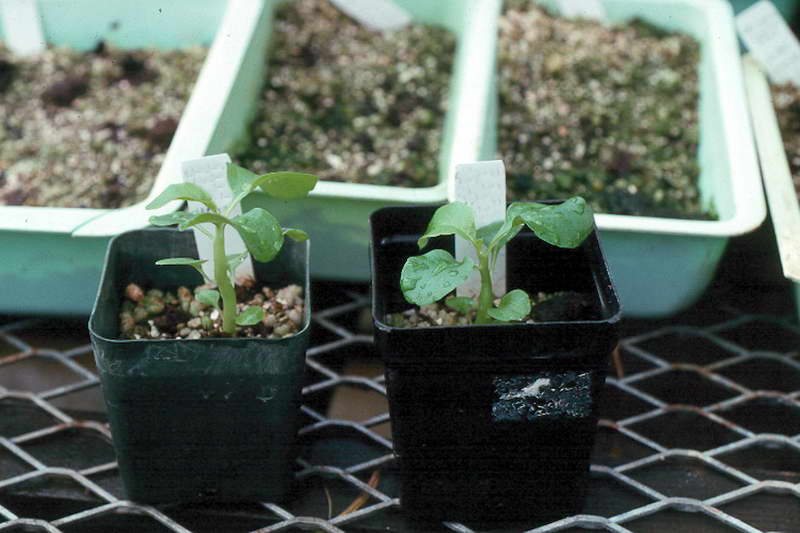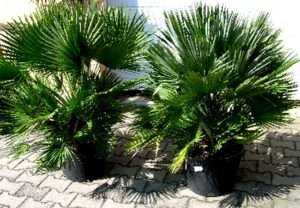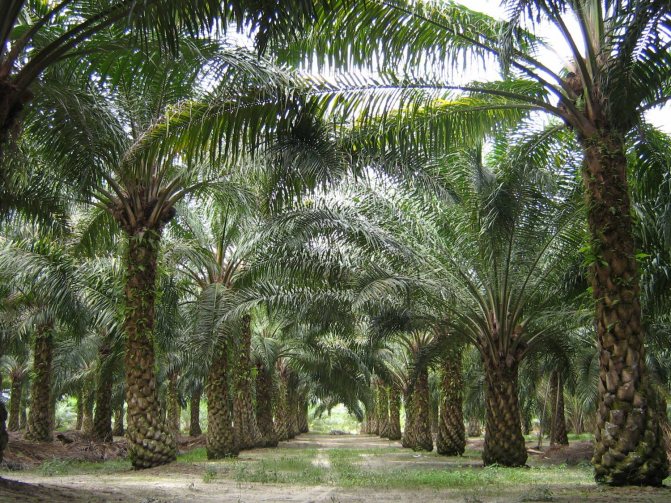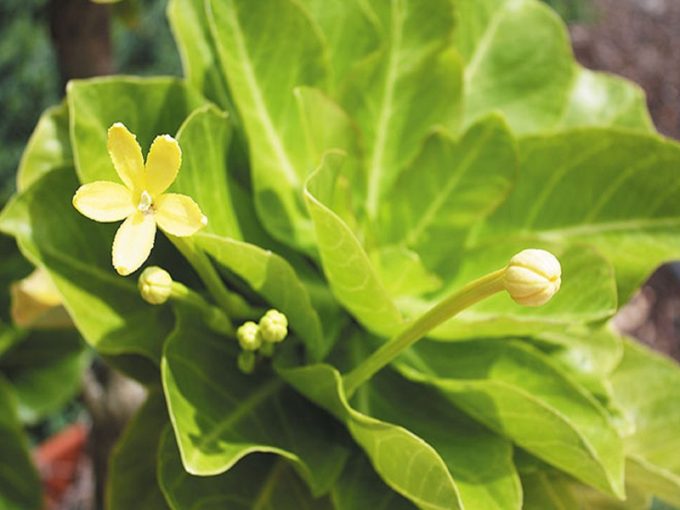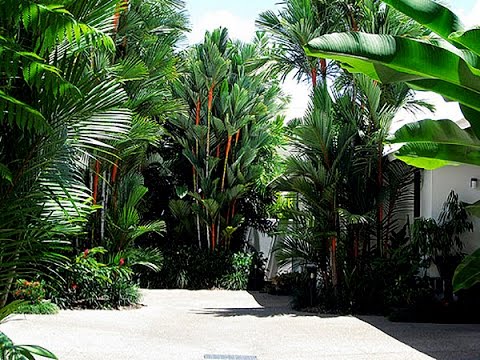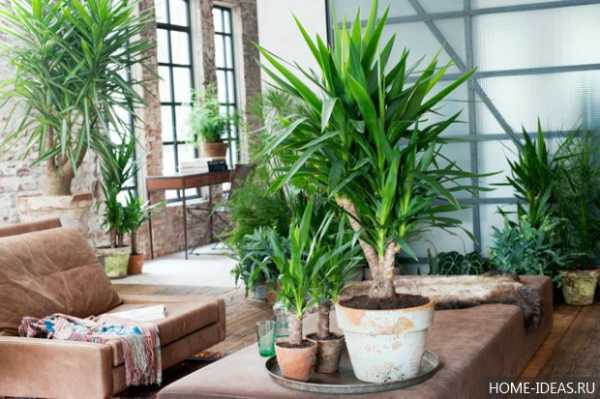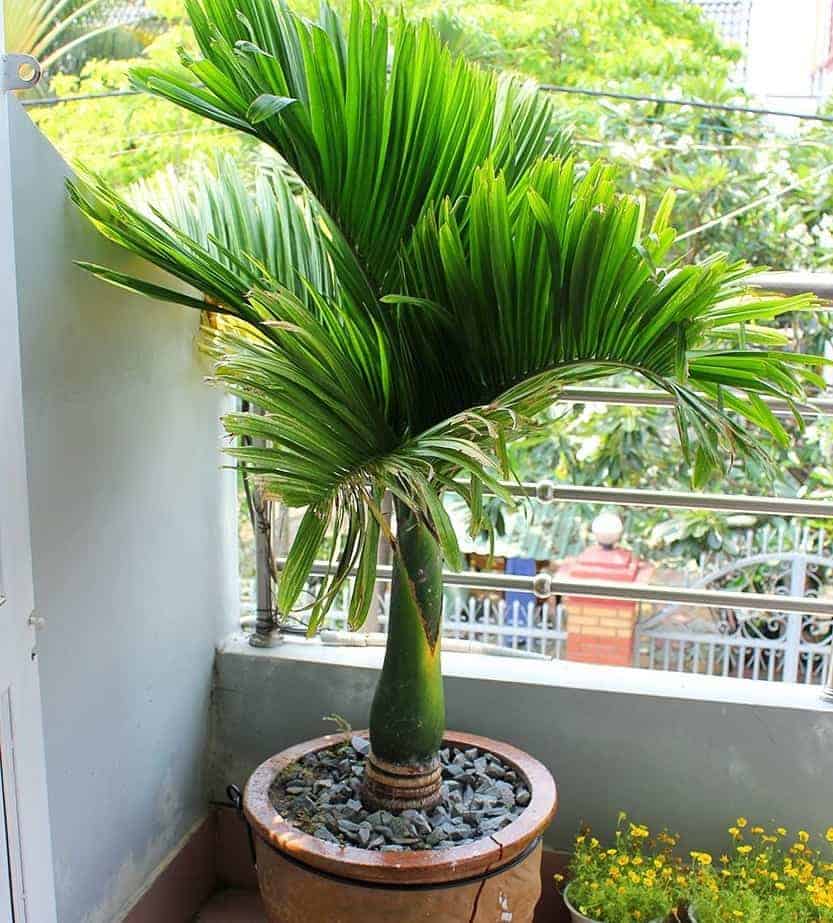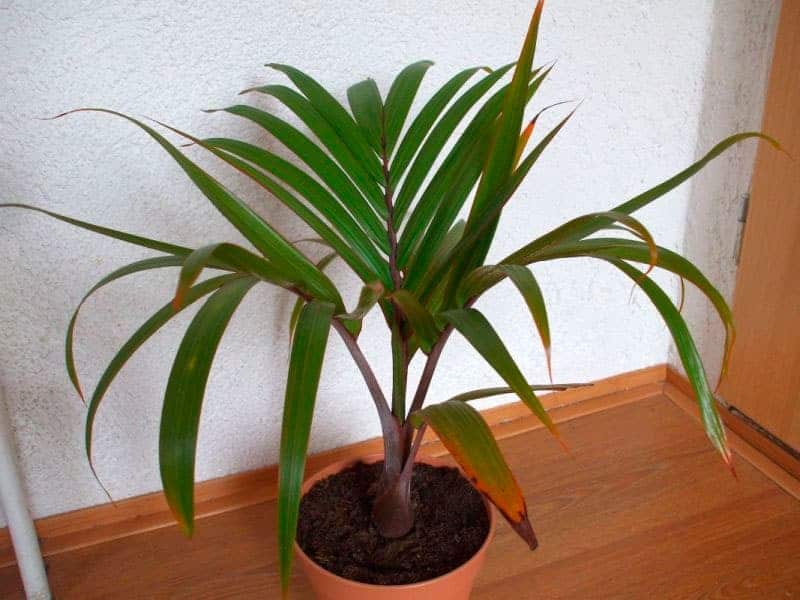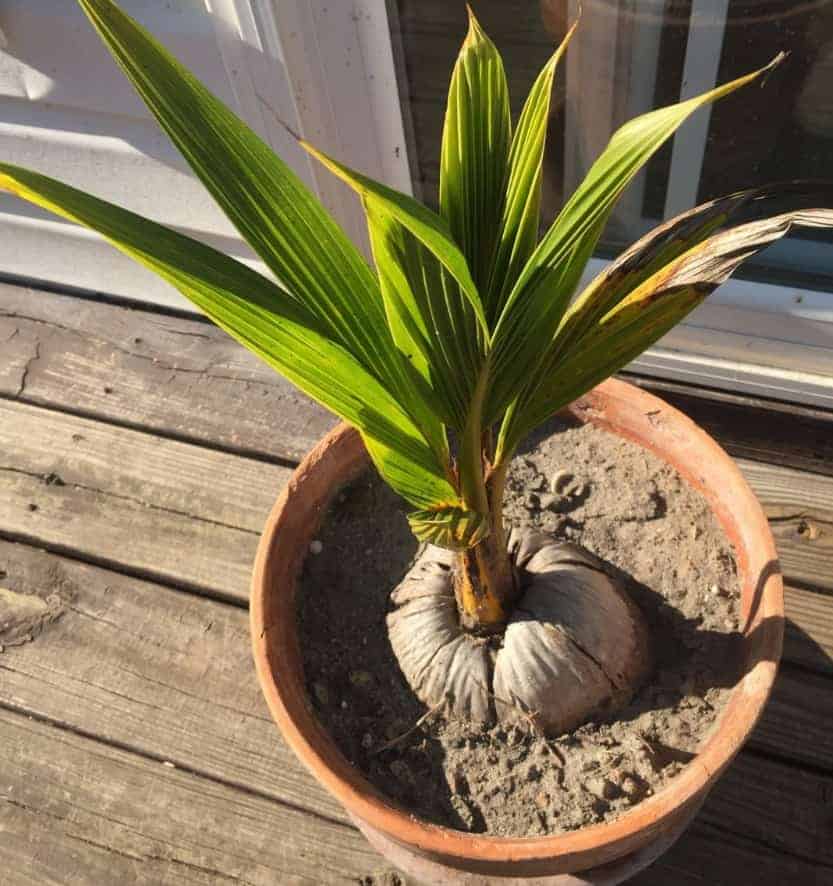Diseases and pests
Diseases
Areca can only get sick with root rot, the development of which is facilitated by too frequent watering. You can understand that a palm tree is sick by the following signs: the bush withers, and brownish-red spots form on the surface of its foliage, which over time increase in size and merge with each other. As soon as such symptoms are found, the plant should be treated as soon as possible with a solution of a fungicide, for example, Discor. If necessary, repeat spraying after 1–1.5 weeks. During the time that the treatment is being carried out, it is impossible to spray the foliage with water or wipe it with a damp sponge.
The palm tree is highly resistant to viruses and bacteria, but problems can arise with it if it is not properly cared for or if it is grown in the wrong conditions. For example:
- The leaves become curly and orange specks appear on them if there is too little potassium in the soil mixture.
- With a lack of nitrogen, the growth of the bush becomes very slow, and the color of its leaves turns pale.
- The yellowing of the foliage is due to the fact that the palm is very rarely or too poorly watered.
- Dry spots of light color that appear on the foliage are sunburn.
- If the room is too cold, the foliage will darken and wilt.
- When the tips of the leaf plates begin to dry, this means that the air in the room is excessively dry.
- Brown and dying bottom plates are a natural process, so there is no need to worry because it happens with all old leaves.
Pests
Mealybugs, spider mites, whiteflies and scale insects can settle on such a palm tree. If you find a white waxy coating on the foliage that looks like cotton wool, this means that mealybugs have settled on the bush. These sucking pests feed on plant sap, as a result of which the areca is greatly weakened, and its growth and development are delayed. Insects are removed by hand using a cotton swab moistened with alcohol or soap solution. Then the bush is sprayed with an insecticidal solution.
Scabbards - also suck the juice from the plant, while they prefer to hide in the leaf axils and on the seamy surface of the leaves. In those areas where there are bites, specks of yellow or brown are formed, while the tissue around them begins to gradually die off. In order to get rid of such a pest, the bush is sprayed with an insecticidal preparation. However, before processing, remove adult insects from the plant by hand, because they are covered with a dense protective shell, and therefore they are not afraid of pesticides.
Whiteflies are small white moths similar in appearance to moths. They prefer to hide on the seamy surface of the foliage, if you shake the bush, then the moths will quickly scatter in different directions. On foliage damaged by such a pest, yellow specks form, and it begins to curl. Also, on the surface of the leaf plates, you can find whitefly excrement, which is a sugar bloom, on which a sooty fungus can settle. You can get rid of the moth with the help of insecticidal preparations.
Spider mites settle on a palm tree if the air in the room is very dry. They are also sucking insects that suck sap from the bush. In areas where there are punctures, dots appear of a pale yellow or light color.You can also understand that this pest has settled on a plant by a thin cobweb on the seamy surface of the foliage. Spider mites are dangerous in that their presence is difficult to notice, and they also multiply rapidly. To exterminate them, areca is treated with a special acaricide.
Most often, in the fight against harmful insects, flower growers use insecticidal acaricidal agents such as: Akarin, Fitoverm, Aktellik and Aktaru, as they can destroy any pest. But remember that these drugs contain poisons that are just as dangerous to humans. Therefore, it is necessary to spray the bush with them in the fresh air and do not forget to observe protective measures.
Varieties and photos
The genus has more than 30 species, some are capable of growing in greenhouses and only a few at home.
Below are photos and descriptions of Liviston palm varieties suitable for reproduction and care in greenhouses and at home.
Chinese (Livistona chinensis)
The diameter of its trunk is small - only 0.4-0.5 m, but in height it stretches quite a bit - up to 10-12 meters. Homeland - South China. From above, the trunk is covered with the remnants of dried fibers of leaves and petioles, its lower part is jagged, rough. The leaves are fan-shaped, drooping, each consisting of 50-80 segments, incised at the tips. The petioles are dense and wide, covered with sharp thorns. Axillary inflorescence is long (up to 100 cm). The photo below shows Livistona Chinese:
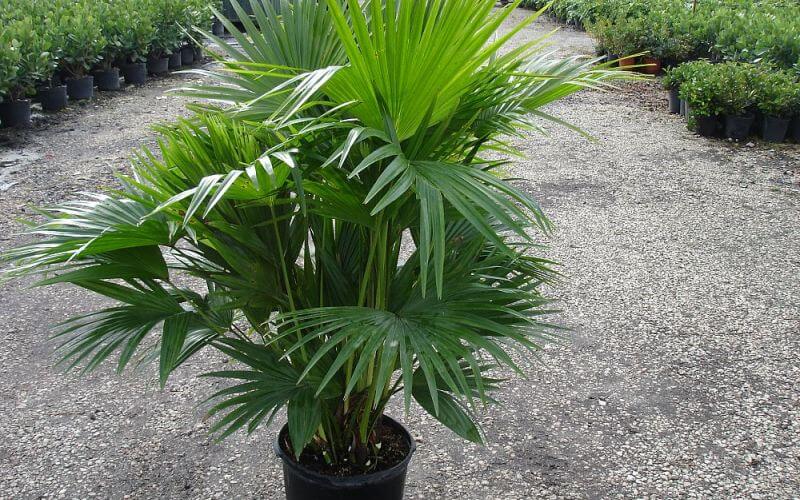
Chinese jade
Very effective appearance: its leaves are spread freely in breadth, in a wide fan, and slightly bent at the ends. Color - emerald green. In the house it grows up to 2-3 meters in height and does not bloom. What the Liviston Chinese jade variety looks like can be seen in the photo below:
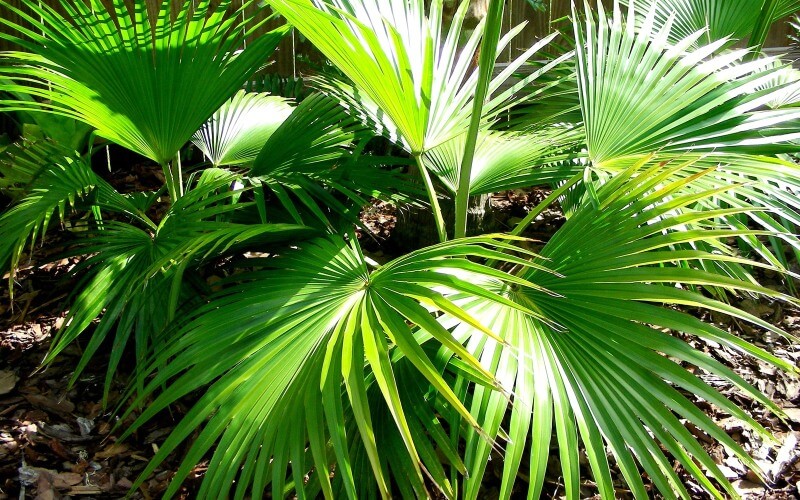
South (Livistona australis)
It was removed from the moisture-saturated forests of Australia. The trunk is thickened at the bottom, covered with hard scars, its diameter is 0.4 meters, and its height is simply staggering - 23-25 meters! The leaves are folded, fan-shaped, divided into lobes, glossy, dark green. Thorns are also present on the petioles. The inflorescence is branched, 1.1-1.3 meters long. In the photo below, the Livistona South variety:
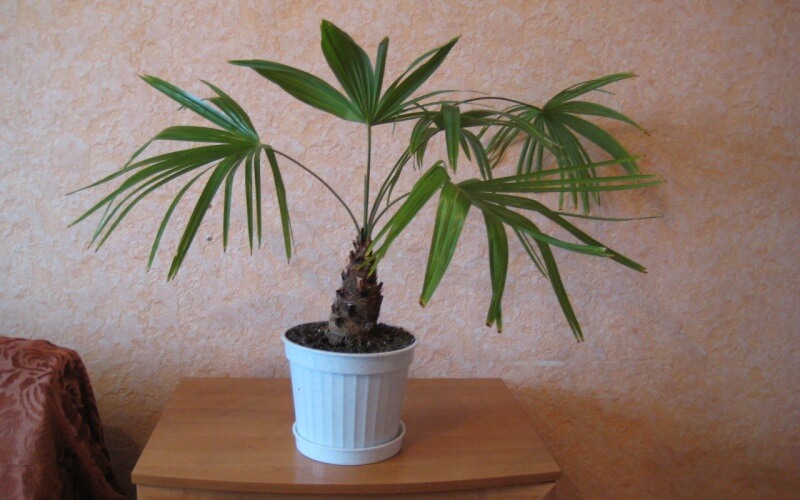
Round-leaved or Rotundifolia (Livistona rotundifolia)
Sprawling, medium-sized (no more than 14 meters). The diameter of the trunk is no more than 17 cm. The leaves are round, glossy, 2/3 of the length are divided into equal segments. Petioles are prickly, tough. Axillary inflorescence reaches 150 cm in length, flowers are pale yellow, small. This type is especially popular with flower growers. Habitat - Moluccas, Java island. The photo below shows Livistona Round-leaved (Rotundifolia):

Indoor plants that look like a palm tree, caring for them
Overseas beauties need a lot of sun, light, moisture, places - conditions close to natural.
Often confused with a palm tree:
- Dracaena;
- Dieffenbachia;
- Beaucarney;
- Yucca.
The flowers look like exotic beauties. They have the same woody stem, which lacks foliage, and a lush top with leaves - fans or feathers.
If you want to have a palm tree at home, but not having a large room, the ability to create conditions for growing, you can limit yourself to breeding flowers that look like tropical inhabitants.
Bocarnea
Nolina is another name for an amazing plant native to Mexico.
- The flower is viable, easily adapts to conditions.
- Easily tolerates temperature fluctuations.
- Doesn't need frequent and regular watering. Sometimes it withstands short-term drying of the soil, dry air, since Bocarnea grows where it rarely rains.
"Bottle tree" (colloquial name for a flower) may have more than one trunk, at the top of which leaves like long narrow ribbons.
Taking care of Bokarnee is easy:
- Water once a week in summer and 20 days in winter.
- The flower is fed with liquid mineral fertilizers for home decorative deciduous plants.Top dressing is applied twice a month (from April to October).
- Bokarnea is not too demanding to the place of residence: it is permissible to place it next to heating devices.
- The root system is superficial, so the flower is planted in a wide pot with drainage holes.
Nolina is growing rapidly. By the age of seven, she becomes an outdoor beauty who will add exotic and southern flavor to any room.
The only drawback is that it does not bloom at home.
Dieffenbachia
The plant is of Hispanic origin. It grows rapidly, reaching two meters in height by the age of five.
A flower with large oval variegated leaves, a powerful green stem. For its unusual beauty, this evergreen culture is loved by flower growers.
Dieffenbachia is capricious to growing conditions:
The flower is afraid of drafts, sudden changes in temperature.
The plant requires a lot of light and sun, but direct sunlight can burn young leaves.
For watering Dieffenbachia, boiled settled water is suitable. In the warm season, the flower is watered more often, more abundantly than in winter. A slightly dry soil surface indicates the need for watering. The plant does not like waterlogging.
Dieffenbachia is pruned to create a lush crown
The flower has a poisonous sap - when pruning, care should be taken (especially for people prone to allergies), work with rubber gloves. Poisonous juice is dangerous for children, pets
If it gets on the mucous membrane, it will lead to undesirable consequences, up to and including death.
Dieffenbachia's variegated foliage will complement the interior with an elegant look. Unfortunately,she does not bloom at home.
Dracaena
The plant is native to the African tropics. A lush flower with straight narrow leaves, pointed at the ends. At home it grows up to half a meter.
One of the advantages of Dracaena is that it is undemanding to growing conditions and care.
- As a tropical inhabitant, Dracene needs moist soil and air. The flower is often watered when it is warm (1 time in two days), less often in winter (2 times a week). Also carry out pouring from the shower, spraying.
- The temperature range for healthy cultivation of Dracaena is + 6 ° -26 ° C.
- In the process of growth, the flower is transplanted into a larger container.
- Breeding a plant is easy on your own. Cut off the top, root - a new flower is ready.
To preserve the decorative characteristics of Dracaena, they create growing conditions close to natural ones (microclimate of the humid tropics).
At home, Dracaena rarely blooms.
Yucca
An evergreen decorative culture from the Agave family, a guest from South America. Yucca painlessly adapts to temperate climates and is viable to cold weather.
Outwardly, Yucca looks elegant. She has large long leaves, like a sword, on a woody two-meter stem.
Caring for Yucca does not require much effort, time consuming:
- The plant is provided with a well-lit, sunny place. Additional lighting is installed in late autumn and winter.
- In winter, the flower is comfortable at temperatures not lower than + 8 ° С, in summer - up to + 27 ° С. With the onset of warmth, Yucca is taken out to the loggia or outside to the garden.
- In warm weather, the plant is watered more often than in winter. Twisted foliage, dry soil in a pot indicate the need for watering.
- They are fed with liquid minerals during active growth 2 times a month.
Home Yucca does not bloom. In nature, its flowers resemble bells.
Cissus care at home
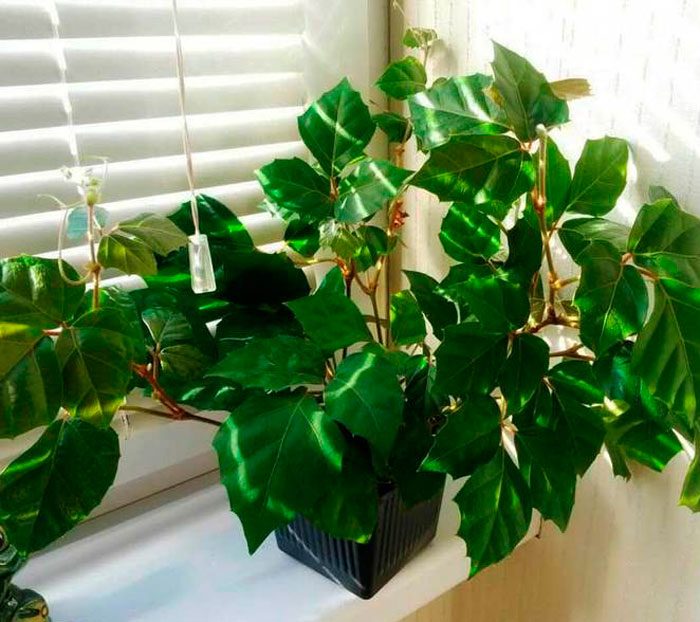
If you decide to grow cissus at home, then you need to take into account that it does not need any special care. However, in order to grow the most effective liana, you need to know in what conditions it is most comfortable to grow. Also, proper care and suitable conditions for growth will be an excellent prevention of various diseases and the appearance of pests.
Temperature regime
Cissus belongs to heat-loving plants, and therefore for normal growth and development it needs: in the summer - from 18 to 25 degrees, and in the autumn-winter period - about 18 degrees. Make sure that the room where the vine is located is not colder than 10 degrees, and it also needs to be protected from sudden changes in temperature and drafts, otherwise all the foliage can fly around it.
Illumination
Needs bright sunlight, but it must be diffused. As a rule, each of the varieties has its own lighting requirements. For example, Antarctic cissus can be grown in shaded areas, so it can be grown in a bathroom or in a hallway with poor lighting. At the same time, rhomboid cissus needs a lot of light.
Watering

Since this is a fast-growing plant with many shoots and lush foliage, special attention should be paid to watering. They should be abundant, but do not allow stagnation of liquid in the root system.
Make sure the potting medium is slightly damp at all times. The bush is watered immediately after the top layer of the soil mixture dries up. From about mid-autumn, watering should be reduced.
Humidity
It needs high air humidity, so the bush needs to be moistened from a sprayer quite often. In winter, this is done twice a day, and in summer - once a day. If the bush is not very large, then you can arrange a warm shower for it. For voluminous vines growing on a support, you need to wipe the foliage from time to time with a damp cloth.
Fertilizer
Liana responds well to feeding with any complete complex mineral fertilizer. It is added to the substrate every 7 days throughout the growing season. In winter, the plant does not need a lot of nutrients, so it is not necessary to feed it. However, it should be borne in mind that if in the cold season a rest period was not organized for cissus, then they continue to feed it, but already once every 15 days and at the same time use a nutrient mixture of a lower concentration.
Transfer

Young bushes are transplanted annually by transferring them into new pots. From the age of five, transplants are carried out less often, namely, once every 2 or 3 years. At the bottom of the pot, do not forget to make a good drainage layer, but fill it with a substrate consisting of sand, good humus, peat, turf and leafy soil, which are taken in equal parts.
Pruning
It is recommended to prune the liana in the spring. For this, the old lashes, which have become less attractive, are shortened. To improve branching, pinching of young shoots is carried out. The plant tolerates pruning well and after it begins to grow actively.
Caring for a boutique palm tree at home
This plant is quite impressive in size, so it will require a lot of space. She should be placed in a spacious, well-lit room in which she will be free. In order for a palm tree to grow and develop normally, you need to know a few rules for caring for it.
Illumination
This plant is not demanding on light. So, it grows well in partial shade and in a sunny place. In a well-lit place, a rather dense crown is formed near the butie, resembling a large ball in its shape, while the leaves will have a bluish color. When grown in partial shade, the leaves will be longer and arched, and in this case they are colored green. If there is too little light, growth may slow down.
Temperature regime
In the summer, the plant thrives at moderate temperatures. However, if for this period it is not possible to take the boutique out onto the street, you need to arrange regular ventilation of the room so that the air does not stagnate.
The resting time of the palm tree is observed from the end of the autumn to the end of the winter period. For this period, it is recommended to rearrange the plant in a fairly cool place from 10 to 15 degrees.
How to water
During the warm season, watering should be regular and abundant, especially if the palm tree is in a sunny place. Make sure that no liquid stagnates in the pot. Overdrying the soil can also harm the plant, because the tips of the leaves that have dried up as a result do not recover over time.
In winter, when a dormant period is observed, it is necessary to water the booth much less often, only after the substrate dries out by 1/3 part.
Air humidity
Despite the fact that a palm tree needs moderate moisture, when grown indoors, the tips of the leaves may begin to dry out. In order to avoid this, it is necessary to regularly moisten the plant from a sprayer with lukewarm soft water. It is recommended to spray it in the morning and in the evening, when the direct rays of the sun will definitely not fall on the foliage.
Earth mixture
A suitable soil must be water and air permeable, slightly acidic (pH 5.0-6.0), and rich in nutrients. Purchased soil for palm trees is suitable for planting. The earthen mixture can be made independently by combining leaf and sod land, as well as coarse sand in a ratio of 3: 3: 1. Do not forget to make a good drainage layer at the bottom, which will help to avoid stagnation of liquid in the substrate.
Fertilizer
Top dressing is carried out during the period of intensive growth once every 2 weeks. To do this, use a special fertilizer for palm trees or a complex fertilizer for decorative deciduous plants.
Transplant features
The plant is rarely transplanted, if absolutely necessary, about once every 4 years, since the palm tree reacts negatively to this procedure. The transplant is carried out in the spring. The topsoil must be replaced once a year. The old soil layer should be removed to a depth of 5 centimeters.
Reproduction methods
It can be propagated by seeds that have little germination. From the moment of sowing to the appearance of the first seedlings, it can take from 6 to 12 months.
Diseases and pests
Scales, spider mites or thrips can settle on the plant. If pests are found, it is necessary to carry out treatment with chemicals for the appropriate purpose.
This is a rather capricious plant and it can get sick as a result of improper care. So, the butia reacts extremely negatively to low air humidity, to improper watering, to insufficient light and to the absence of a rest period with moving to a cool place. In this regard, before you start growing a palm tree, you need to think carefully about whether you can handle caring for it.
The record of Palma Butea first appeared The Plant Grower.
Reproduction
Hamerops reproduce in the following ways:
- With the help of seeds;
- Shoots;
- By dividing the root.
Let's consider all the options in more detail.
Seeds
At home, when growing a palm tree from seeds, it is important to maintain the temperature within 25-30 degrees. The seeds are placed in pre-prepared soil to a depth of 1-2 centimeters and cover the pot with wet moss
This plant takes a long time to germinate, so please be patient. Strong shoots will appear only after 2-3 months
The seeds are placed in pre-prepared soil to a depth of 1-2 centimeters and the pot is covered with wet moss. This plant takes a long time to germinate, so please be patient. Strong shoots will appear only after 2-3 months.
The first leaves of the palm are whole. Fan leaves appear only in the 2nd year of life.
By shoots
Hamerops reproduces vegetatively using lateral processes
They should be carefully separated so as not to touch the roots and planted in a prepared soil mixture for young plants.
Root division
This method is suitable for reproduction of old hamerops, which have a strengthened root system. An adult plant is carefully removed from the pot, divided into parts, each of which should have healthy roots.Hamerops need to be transplanted into solid soil, prepared in advance and well moistened.
Diseases and pests
- Why do palm leaves dry and what to do? Sometimes a florist with annoyance notices that the tips of the leaves of Livistons dry even with good care. And he makes the mistake of pruning them. Do not hurry! This is a natural phenomenon that can be dealt with with a regular sponge: just wipe the leaves with water more often. If such manipulations do not bring results, the point is either a lack of nutrients, or direct sun exposure to the plant. Shade the plant, revise the fertilization schedule.
- If the indoor palm tree has stopped growing, it is most likely that the temperature is too low.
- Decay of roots and lethargy of leaves indicate a fungal attack. Treat the palm with a fungicide and transplant it into new soil.
What pests is Liviston afraid of?
- Mealybug. It settles in the sinuses, leaves a sticky white bloom on the trunk, similar to wet cotton wool. It is possible to destroy the pest with the help of the preparations "Inta-vir", "Talstar", "Aktellik".
- Spider mite. It is easy to distinguish it from other pests - it entangles leaves and buds with a thin cobweb. Acaricides suitable for destruction: Fitoverm, Demitan, Talstar.
- Shield. Its appearance is signaled by brown round specks on the leaves, sticky to the touch. Adult pests should be removed with a napkin moistened with alcohol, and then the palm should be treated with Aktellik or Inta-vir.
 If there are few pests, folk recipes will come to your aid. For example: chop one onion, pour a glass of boiling water and let it brew for 2-3 hours. Spray the palm tree with the cooled solution. The garlic solution is prepared in the same way.
If there are few pests, folk recipes will come to your aid. For example: chop one onion, pour a glass of boiling water and let it brew for 2-3 hours. Spray the palm tree with the cooled solution. The garlic solution is prepared in the same way.
The following composition will help against scale insects: 20 ml of sunflower oil and 1 g of soap, diluted in a glass of warm water. Cover the soil in the tub with oilcloth and treat the Liviston with the mixture. Wash off after 6 hours.
Diseases and treatment
-
- What to do if the leaves dry? There can be several explanations for this. If the problems began soon after transplanting, you either picked up the wrong pot (for a small palm tree - a large flowerpot), or damaged the roots, or made the wrong potting mix. Another option - the purchased soil was infected with pests, and you forgot to process it.
- Brown spots on the leaves indicate that the plant has received a sunburn.
- The dying off of foliage signals that the room temperature is too high.
- If the hovea stops growing and the leaves turn pale, it lacks nitrogen.

- Lack of light and low temperature of the content causes chlorosis of the lower leaves.
- Spots on elliptical leaf plates appear when using copper-containing preparations.
- Do leaf tips turn brown and then die off? You are overfeeding your plant.
- Root rot is caused by excess moisture. If the lesion is small, try cutting out the damaged area with a disinfected blade. With a large area, saving a palm tree will not work.
- Mealybug damages both roots and stems. Having settled in the axils of the leaves, it begins to actively develop new territories, sucking juice from the plant. The leaves are covered with brown spots, curl and wither, the palm stops growing. Folk remedies will not help here. Adult insects are collected by hand, and then the plant is treated with an insecticide "Aktara", "Aktellik", "Bankol", "Inta-vir", "Vermitic". In total, at least 3 treatments are carried out with a 10-day interval.
- Aphids pierce the leaves and also feed on sap, leaving behind sticky traces - a medium for the growth of the fungus. The palm turns yellow and does not grow. Hovei should be washed with green soap under the shower to wash off adult aphids, and the larvae should be removed with a cotton swab dipped in onion or tobacco infusion. If there are many pests, only a special tool "Confidor", "Alatar", "Tiara", "Warrant", "Tanrek", "Biotlin", "Confidor" will help.
- The spider mite settles on the leaves and in the axils, entangling the plant with cobwebs. The leaves are covered with punctures and yellow sores, rough to the touch. Suitable preparations: biological ("Akarin", "Fitoverm", "Agravertin") and chemical ("Fufanon", "Omite", "Apollo", "Actellik", "Neoron").
Domestic palm tree: description
Palm trees are an interesting houseplant. Mature trees often grace public spaces and foyers, adding an elegant and distinctly tropical air to the decor. At the same time, very small, immature trees are sometimes used as table plants, kept in tiny pots.
It is believed that palms do not need fertilization, or at least they do not need much. This is not true. The palm tree can cling to life without regular fertilization, but if you want healthy trees, you need to periodically give the plants a variety of fertilizers. It is necessary both indoors and in tropical and subtropical gardens.

